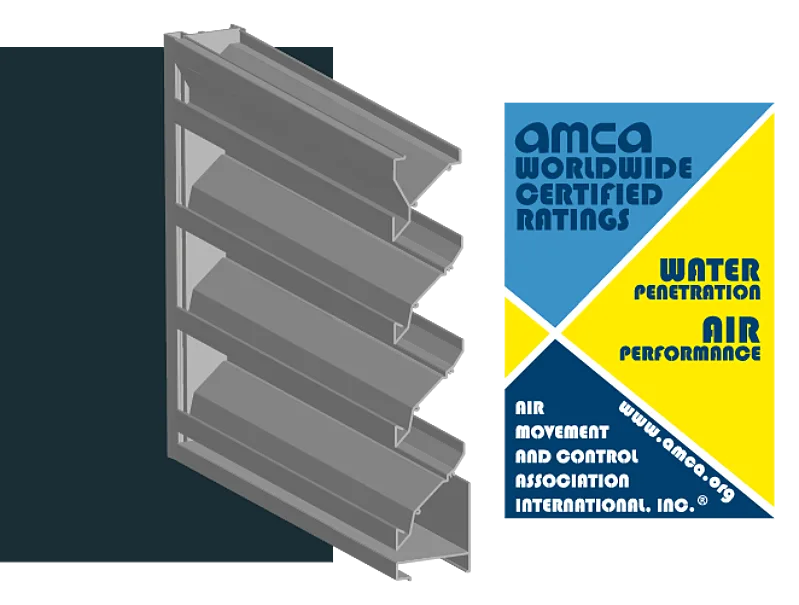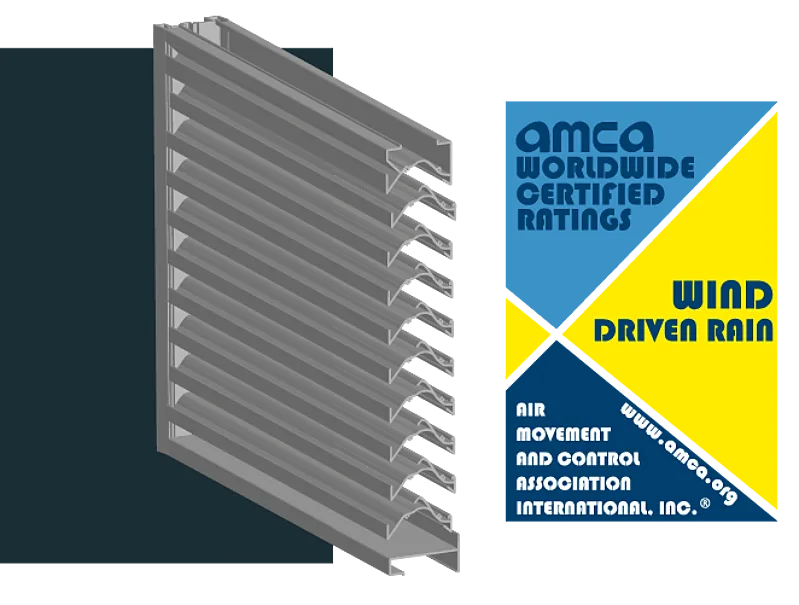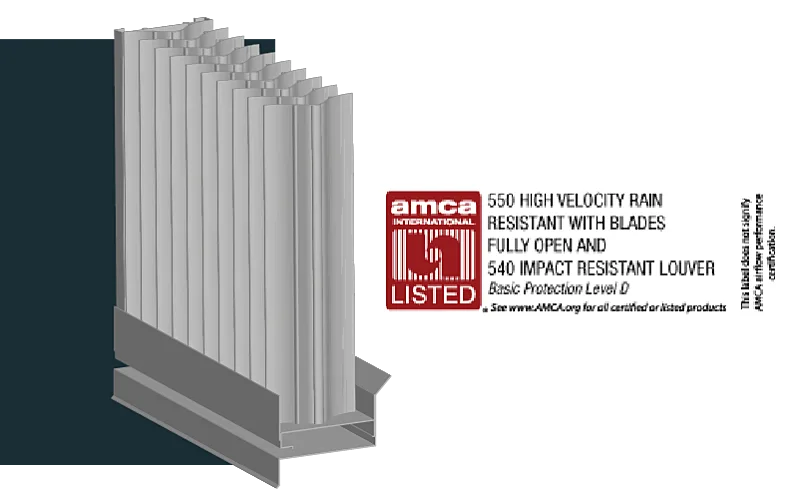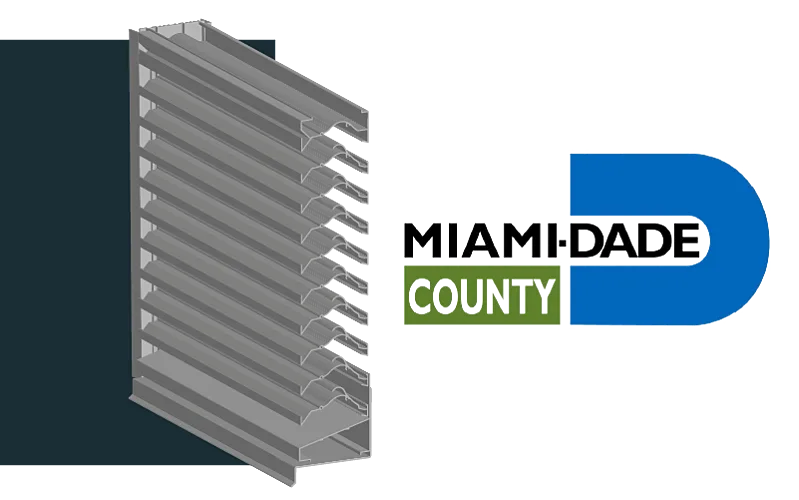What makes a storm ready louver? Louvers can have many features to prepare them for severe weather, like drain troughs and blade catches, but they aren’t ready until they have been tested. Tests provide data on how the louver will perform in the field.
Each louver must protect your interior spaces from water damage. Several tests are available for louvers, established by AMCA and other institutions like the Miami-Dade County Building Department. In this article, we will focus on the tests for a louver's storm preparedness.
AMCA Water Penetration
Many consider water penetration testing as a baseline for storm protection.

Louvers undergo water penetration testing in accordance with AMCA 500-L for louvers. Manufacturers can test this independently or with other tests, such as wind-driven rain testing.
This is a common testing standard, and many louvers undergo testing to receive an AMCA Certified Ratings Seal. Even severe weather louvers can receive an AMCA seal for water penetration.
Water penetration testing determines the point in air velocity when rain will infiltrate the louver. This point will be the louver’s beginning point of water penetration. AMCA configures the test for intake during still wind conditions. A fan will draw air through the louver while water slides over the face of the louver.
The air velocity refers to the speed of the intake air drawn by the system fan, not the speed of wind moving towards the louver.
The test ends when 0.01 ounces of water penetrates the louver, or when the intake air velocity reaches 1250 feet per minute. Manufacturers will present the test data on the louver’s submittal, along with the beginning point of water penetration and an AMCA ratings seal for Water Penetration.
AMCA Wind Driven Rain
Testers conduct wind-driven rain testing under AMCA 500-L, like water penetration testing. However, this test involves air moving towards the louver during air intake.

Where water penetration tests assume still air conditions, wind driven rain testing measures water penetration from gusts and high winds. Also, wind driven rain testing measures that amount of water that infiltrates the louver.
In a wind driven rain test, louvers must withstand simulated storm conditions at various rates of rainfall and at various wind speeds. At intervals, testers will measure the amount of rainwater that infiltrates the louver and will assign the louver with an Effectiveness Class. This rating is a percentage of the total amount of rain rejected by the louver during the test.
Effectiveness Class A is the best classification. It signifies that the louver rejected 99% or more of the incoming rainfall during the test. Once complete, louvers receive the AMCA Certified Ratings Seals for Wind Driven Rain.
Manufacturers will also present the test data on the louvers’ submittals. Severe weather louvers will often have a ratings seal for wind driven rain.
If they are both conducted on the louver, then water penetration and wind driven rain will be listed on the same seal. Each test provides complimentary data on the louver’s storm readiness.
AMCA 540 and 550
AMCA designed AMCA 540 and 550 for hurricane louvers.

Each standard measures a different aspect of the louver’s capabilities during an extreme weather event. AMCA 540 determines the louver’s capability to resist debris impacts. During a category 1 hurricane, winds can still lift debris off the ground and launch it towards buildings. Hurricane louvers must remain intact if debris strikes them.
Testers will launch wood planks at key points of the louver’s frame. If the louver loses a blade, or deforms out of shape, then it fails the impact test. AMCA 550 determines the louver’s ability to reject high velocity wind driven rain.
Testers subject a louver to rain and wind in a test chamber, like the standard wind-driven rain test. The test measures water infiltration at several intervals.
For AMCA 550, the simulated speed will reach 110 miles per hour. Instead of an effectiveness class, the louver must reject 99% of all wind driven rain to pass the test. The louver would need to receive an effectiveness class A at much higher wind speeds to pass AMCA 550 testing.
For all completed tests, AMCA will provide the hurricane louver an AMCA Listing Label. The results are pass or fail. If the louver’s submittal has the listing label, then it passed the listed tests. There will be no additional data presented on the submittal.
Miami-Dade
Hurricane louvers may also receive testing under Miami-Dade’s hurricane protection standards.

These standards pertain to high velocity hurricane zones (HVHZs) in Florida, but they have been used in other parts of the country as a standard for hurricane louvers. Modern projects will call for louvers that meet AMCA 540 and 550, but some projects may still call for Miami-Dade approval.
Louvers that complete Miami-Dade testing standards will have a Notice of Approval (NOA) filed with the Miami-Dade County Building Department. The results of Miami-Dade testing are presented in the NOA and not on the louver’s submittal.
Manufacturers may display the louver’s NOA number on its submittal, which you can research online.
Manufacturers test their louvers to ensure each unit protects ventilation points and interior spaces during a storm. AMCA provides testing standards. A ratings seal or listing label shows an AMCA approved laboratory conducted fair tests and that all data is accurate.
AWV and Storm Ready Louvers
Need storm ready louvers for an upcoming project? AWV builds severe weather and extreme weather louvers, as well as standard ventilation louvers and architectural louvers. We build each product to your specifications, so that it meets your requirements and fits into your project. Browse our full catalog online. Ready to start? Contact AWV today.






